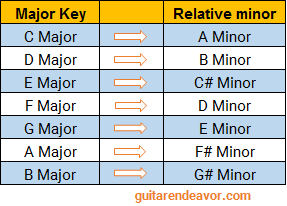

The tonic, subdominant, and dominant chords, in root position, each followed by its parallel. In C major thence arises an apparent A minor triad (Tp, the parallel triad of the tonic, or tonic parallel), D minor triad (Sp), and E minor triad (Dp). The substitution of the major sixth for the perfect fifth above in the major triad and below in the minor triad results in the parallel of a given triad. Riemann defines the relation in terms of the movement of one single note: In Hugo Riemann's theory, and in German theory more generally, these chords share the function of the chord to which they link: subdominant parallel, dominant parallel, and tonic parallel. Parallel and counter parallel chords are terms derived from the German ( Parallelklang, Gegenparallelklang) to denote what is more often called in English the "relative", and possibly the "counter relative" chords. The similarity between the subdominant and supertonic chords is easily seen and heard through the supertonic seventh chord Play ⓘ. Dominant and dominant parallel in C minor: Gm and B ♭M chords Play ⓘ. Dominant and dominant parallel in C major: GM and Em chords Play ⓘ. Play ⓘ Subdominant and subdominant parallel in C minor (sP): Fm and A ♭M chords Play ⓘ. Subdominant and subdominant parallel in C major (Sp): FM and Dm chords. Tonic and tonic parallel in C minor: Cm and E ♭M chords Play ⓘ. We can apply the parallel approach visually using our scale finder and shifting the mode patterns learned so far to the key of C.See also: Parallel key, Parallel harmony, and § Leittonwechselklänge Tonic and tonic parallel in C major: CM and Am chords Play ⓘ. The major modes, the ones with the major 3rd, are: Ionian, Lydian and Mixolydian. The minor modes are Dorian, Phrygian, Aeolian and Locrian (to be more precise, the Locrian would be a diminished Like in chords, we can divide the modes in minor modes and major modes, by looking at their 3rd degree: Minor Modes Yes, Parallel modes share the same root.Īs an aside, parallel modes are at the foundation of modal interchanges, a way to make chord progressions more interesting.īy looking at the steps and half-steps in the relative modes table, we can derive the formula for each mode: Mode Name With the Parallel approach, we take all the modes we have learned with the Relative approach, and translate them to the same root.
C major relative chords how to#
To learn how to apply modes to real music, we also have to deal with the parallel approach The Modes: Parallel Approach

If we would stop here, modes would be just an unuseful complication: why bother with strange names if they share the same notes and we are just playing the major scale with different patterns? The picture below shows all the relative modes display together: as you'll notice, they form a fretboard map of the major scale! To complete the puzzle, we also need the parallel approach (see below). With our scale finder, we have created the following patterns: Each starting note gives life to a very specific feeling, even if we use only notes of the major scaleĪt this point, guitarists usually learn how to play these seven modes on the fretboard, even if this relative approach only teaches 7 different ways to play the major scale (more Try to play these sequences and listen to the sound. You'll notice that the Ionian Mode is exactly the same of the Major Scale, and the Aolian Mode is another name for the Minor By expanding the concept of relative minor scale, we have: Starting Note Again, same note of the major scale, but played starting from a different degree (6th). In the case of the C major scale, the relative minor is the A minor scale. Probably you have already encountered the concept of relative minor scale: the scale built from the sixth degree of a major scale is called relative minor. Each starting note gives life to a very specific feeling, even if we use only notes of the major scale How The Relative Approach Relates To Modes? As the notes involved here are only the ones composing the major scale, we can say that we've just seen different ways to play the major scale.


 0 kommentar(er)
0 kommentar(er)
